Lunar eclipse - Study guides, Class notes & Summaries
Looking for the best study guides, study notes and summaries about Lunar eclipse? On this page you'll find 209 study documents about Lunar eclipse.
Page 2 out of 209 results
Sort by
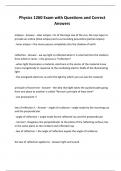
-
Physics 1260 Exam with Questions and Correct Answers
- Exam (elaborations) • 8 pages • 2024
-
- $12.49
- + learn more
eclipses - Answer - solar eclipse = bc of the large size of the sun, the rays taper to provide an umbra (total eclipse) and a surrounding penumbra (partial eclipse) - lunar eclipse = the moon passes completely into the shadow of earth reflection - Answer - we say light is reflected when it is returned into the medium from which it came -> the process is *reflection* - when light illuminates a material, electrons in the atoms of the material move more energetically in response to the osc...
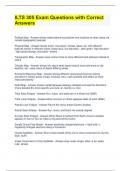
-
ILTS 305 Exam Questions with Correct Answers
- Exam (elaborations) • 7 pages • 2024
- Available in package deal
-
- $13.89
- + learn more
ILTS 305 Exam Questions with Correct Answers Political Map - Answer-shows state/national boundaries and locations of cities (does not include topographic features) Physical Map - Answer-shows rivers, mountains, forests, lakes, etc. with different features shown in different colors (water-blue, low elevation - dark green, high elevation - light green/orange, mountains -brown) Topographic Map - Answer-uses contour lines to show different land features instead of colors Climatic Map - ...
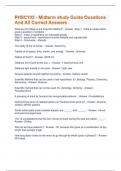
-
PHSC102 - Midterm study Guide Questions And All Correct Answers
- Exam (elaborations) • 8 pages • 2024
-
- $8.99
- + learn more
PHSC102 - Midterm study Guide Questions And All Correct Answers What are the Steps to the Scientific Method? - Answer -Step 1- make an observation, pose a question or problem Step 2 - make a hypothesis (an educated guess) Step 3 - experiment - hypothesis must be testable and reproducible Step 4 - Conclusion - Results The study of the Universe. - Answer -Astonomy Totality of all space, time, matter, and energy. - Answer -Universe Radius of Earth? - Answer -6378 Km Distance from ...
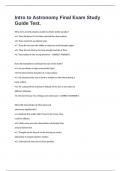
-
Intro to Astronomy Final Exam Study Guide Test.
- Exam (elaborations) • 22 pages • 2024
- Available in package deal
-
- $14.49
- + learn more
Intro to Astronomy Final Exam Study Guide Test. Why were ancient peoples unable to detect stellar parallax? • A. They did detect it, but they rejected the observations • B. They could not see distant stars • C. They did not have the ability to measure small enough angles • D. They did not observe for long enough periods of time • E. They looked in the wrong direction - CORRECT ANSWER C How did Eratosthenes estimate the size of the Earth? • A. He sent fleets of ships aroun...
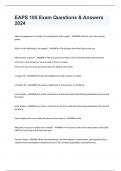
-
EAPS 105 Exam Questions & Answers 2024
- Exam (elaborations) • 10 pages • 2024
- Available in package deal
-
- $8.49
- + learn more
EAPS 105 Exam Questions & Answers 2024 Which arrangement is in order of increasing size, left to right? - ANSWER-• Planet, star, solar system, galaxy Which of the following is the largest? - ANSWER-• The distance from the Earth to the sun What causes seasons? - ANSWER-• The sun spends less time in the sky during winter than summer. • The Sun's rays spread out more in winter than in summer. • The suns rays are more spread out over the Earth in the winter • Larger Tilt...
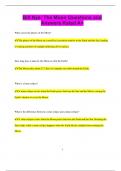
-
Bill Nye: The Moon Questions and Answers Rated A+
- Exam (elaborations) • 7 pages • 2024
- Available in package deal
-
- $9.76
- + learn more
Bill Nye: The Moon Questions and Answers Rated A+ What causes the phases of the Moon? The phases of the Moon are caused by its position relative to the Earth and the Sun, leading to varying amounts of sunlight reflecting off its surface. How long does it take for the Moon to orbit the Earth? The Moon takes about 27.3 days to complete one orbit around the Earth. What is a lunar eclipse? A lunar eclipse occurs when the Earth passes between the Sun and the Moon, causing the Earth...
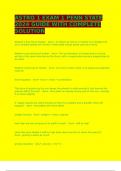
-
ASTRO 1 EXAM 1 PENN STATE 2024 GUIDE WITH COMPLETE SOLUTION
- Exam (elaborations) • 7 pages • 2024
-
- $12.99
- + learn more
ASTRO 1 EXAM 1 PENN STATE 2024 GUIDE WITH COMPLETE SOLUTION Newton's first law of motion Ans- an object at rest or in motion in a straight line at a constant speed will remain in that state unless acted upon by a force Newton's second law of motion Ans- The acceleration of a body due to a force will be in the same direction as the force, with a magnitude inversely proportional to its mass Newton's third law of motion Ans- for every action, there is an equal and opposite reactio...

-
PHY-105 Creighton University Exam All Possible Questions and Answers with complete solution
- Exam (elaborations) • 3 pages • 2024
- Available in package deal
-
- $9.69
- + learn more
PHY-105 Creighton University Moon - an object which orbits a planet Asteroid - small rocky object which orbits a star Comet - small icy object which orbits a star Planet - large object in space that orbits a star and does not produce light of its own (reflected light) Solar System - a star and all the materials which orbit it - planets and moons Star - a giant ball of hot gas (ranges in color and sizes) Nebula - a large cloud of dust and gas in space Galaxy - a great island of stars in ...
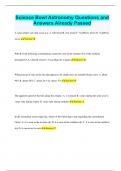
-
Science Bowl Astronomy Questions and Answers Already Passed
- Exam (elaborations) • 26 pages • 2024
- Available in package deal
-
- $9.99
- + learn more
Science Bowl Astronomy Questions and Answers Already Passed A solar eclipse can only occur at a: A. full moon B. new moon C. 1⁄2 gibbous moon D. 1⁄4 gibbous moon Answer: B Which of the following constellations cannot be seen in the summer sky of the northern hemisphere? A. Libra B. Orion C. Ursa Major D. Cygnus Answer: B What percent of stars in the sky that appear to be single stars are actually binary stars: A. about 90% B. about 50% C. about 20 % D. about .5% Answer: B T...
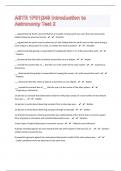
-
ASTR 1P01|249 Introduction to Astronomy|16 Pages
- Exam (elaborations) • 16 pages • 2024
-
- $8.49
- + learn more
__ argued that the Earth cannot be flat b/c a traveller moving south sees stars that were previously hidden below the previous horizon - ️️Aristotle __ argued that the earth must be spherical, b/c the shadow that the earth casts on the moon during a lunar eclipse is always part of a circle, no matter the moon's position - ️️Aristotle __ determined that gravity is responsible for keeping the Moon in it's orbit around the earth - ️️Newton __ discovered that the orbits of planets a...

How did he do that? By selling his study resources on Stuvia. Try it yourself! Discover all about earning on Stuvia


